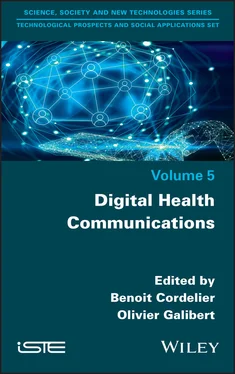Digital Health Communications
Здесь есть возможность читать онлайн «Digital Health Communications» — ознакомительный отрывок электронной книги совершенно бесплатно, а после прочтения отрывка купить полную версию. В некоторых случаях можно слушать аудио, скачать через торрент в формате fb2 и присутствует краткое содержание. Жанр: unrecognised, на английском языке. Описание произведения, (предисловие) а так же отзывы посетителей доступны на портале библиотеки ЛибКат.
- Название:Digital Health Communications
- Автор:
- Жанр:
- Год:неизвестен
- ISBN:нет данных
- Рейтинг книги:3 / 5. Голосов: 1
-
Избранное:Добавить в избранное
- Отзывы:
-
Ваша оценка:
- 60
- 1
- 2
- 3
- 4
- 5
Digital Health Communications: краткое содержание, описание и аннотация
Предлагаем к чтению аннотацию, описание, краткое содержание или предисловие (зависит от того, что написал сам автор книги «Digital Health Communications»). Если вы не нашли необходимую информацию о книге — напишите в комментариях, мы постараемся отыскать её.
Digital Health Communications — читать онлайн ознакомительный отрывок
Ниже представлен текст книги, разбитый по страницам. Система сохранения места последней прочитанной страницы, позволяет с удобством читать онлайн бесплатно книгу «Digital Health Communications», без необходимости каждый раз заново искать на чём Вы остановились. Поставьте закладку, и сможете в любой момент перейти на страницу, на которой закончили чтение.
Интервал:
Закладка:
This first approach to the PMR will be continued in Chapter 2, written by Pénélope Codello, David Morquin, Ewan Oiry and Roxana Ologeanu-Taddei. The four authors propose an ambitious monographic research project on the implementation of the EMR, the electronic medical record, whose logic of digital traceability of the patient’s medical characteristics, similar to the PMR, points to the same organizational paradoxes discussed in Chapter 1: the very negative feelings of healthcare professionals towards an IT tool that bureaucratizes activity and distances them from patients. Beyond the enlightening results that these researchers produce, at the crossroads of ICS and management sciences, they rehabilitate and frame the questionnaire as a valid method for studying practices. They are thus opening up new avenues of empirical investigation, by restructuring a quantitativist investigative tool that, combined with comprehensive (semi-directive interviews) and ethnographic (practice observations) tools, proves to be conducive to a form of generalization.
In Chapter 3, we will extend our investigations into new forms of technological rationalization of the production of care by moving the focus to the patients. In this research, Anne Mayère is more particularly interested in putting the patient to work through the use of digital services that aim to replace the care provided by the healthcare professional. In the already-mentioned context of reducing hospitalization time and enhancing outpatient and/or home care, telemedicine and the remote monitoring devices used imply invisible work on the part of the patient. Anne Mayère shows us how patients, remotely connected to healthcare professionals, are forced to apply protocols mechanically. They therefore undergo a form of evaluation of their performance. Taking up Foucault’s concept of pastoral power , Anne Mayère also shows the paradox of an injunction to empower a patient who must become a co-producer of the care she or he receives, but who very often remains the executor of therapeutic processes based on a form of disciplinary power.
I.2. What about digital communication in health… ethical, empowering and emancipating?
In the second part of the book, we will focus more specifically on the digital info-communication logics likely to spread an ethic of care, synonymous with comprehensive, humanistic and emancipatory care for patients and caregivers.
In Chapter 4, the focus shifts to a more emotional approach and relational aspects of digital communication. While questioning the new mediations used between professionals for the home care of extremely vulnerable patients, Géraldine Goulinet Fité proposes revisiting the tension between cure and care through information and communication. If the cure embodies a technical medicalized approach to the individual patient, the care is part of a relational and humanistic ethics of the care of the sick person. The author relies on the observation of a socio-digital platform for coordinating the interprofessional action of the private health professionals involved in this home care. This chapter then provides an opportunity to classify SICDs with a medical aim into two main categories: on the one hand, remote monitoring techniques specific to the cure, which seem problematic in terms of their integration into care; and, on the other hand, more relational techniques, specific to care , which allow carers to express their feelings more freely about a patient’s situation and which remain deeper and more valued by professionals. Taking the time to explain all of the social, psychological and emotional dimensions of the therapeutic process, Géraldine Goulinet Fité wonders whether the interactions between caregiver and patient are not to be favored in order to build a digital communication in health care that meets the ethics of care, which is accepted by all, patients and professionals alike.
Chapter 5is an opportunity for Dorsaf Omrane and Pierre Mignot to extend this reflection on digital communication in health, which is no longer just technical, attached to the logic of the cure, but more relational, strongly marked by the ethics of care, based on remote social support. With the help of a monographic search centered on the Facebook community “ Le cancer du sein, parlons-en ! ”, the two researchers point out the info-communicational limits of institutional preventive messages. In this online community for breast cancer patients, the mistrust or suspicion of persuasive messages from the community manager is revealed in the abundant interactional activity generated by messages from the patients themselves. As a result, the experiential content, valuing experience and emotion, has a greater impact. This would tend to support the hypothesis that digital communication, embodied by patients themselves and conveying all the dimensions of care, would be the most effective.
I.3. What about new digital mediations of health knowledge?
The third and last part of the book offers an overview of the changes in health expertise under the action of digital informational and communicational processes. The aim is to address, via three complementary texts, the causes and consequences of the competition between biomedical expert knowledge and lay experiential knowledge.
In Chapter 6, Hélène Romeyer therefore invites us to explore the emergence of lay medical expertise and its institutionalization in the figure of the expert patient. Based on a comprehensive empirical approach conducted through semi-directive interviews with expert patients, the reflection presented returns to the passage from a so-called paternalistic, authoritarian and top-down medicine to a so-called participatory medicine, sharing skills between health professionals and nonprofessionals, and supported in France by a legal arsenal that, since the Kouchner Act of 2002, encourages the patient to become a co-producer of the care he or she receives. So, how does digital communication contribute to this participatory injunction aimed at patient empowerment? Hélène Romeyer supports the hypothesis of a correlation between the professionalization of expert patients, whose role in institutions and other healthcare organizations is becoming central (notably as a vector of therapeutic education) and the mastery of digital tools. The profession of the expert patient would therefore be nourished mainly by strong skills in digital communication. From then on, the figure of the expert patient renews the issue of the patient’s digital work, already addressed by Anne Mayère in Chapter 3, by insisting not on its invisibility, but on its recognition. This is not without repositioning the issues of digital literacy at the center of the reflection on the empowerment of a patient who we want to be as involved as possible in his or her healthcare journey.
Following this overview of the sociotechnical questions inherent to the figure of the expert patient, Stéphane Djahanchahi, Olivier Galibert and Benoit Cordelier propose, in Chapter 7, to continue the categorization of digital expertise in health. The aim is to understand the new mechanisms for mediating digital knowledge, which is now combined in the plural. Based on an ethnography of several online communities bringing together the actors involved in therapeutic cannabis (patients, cannabis growers, promoters of alternative medicines, etc.), the three authors update strategies for the recognition of an intra-community expertise deployed on the basis of a strong opposition with expert biomedical knowledge. Social logics of legitimization thereby emerge, produced in an info-communicational context more or less marked by an idealization of the model of the virtual or online community constituted around values of altruism, generosity and social esteem.
Читать дальшеИнтервал:
Закладка:
Похожие книги на «Digital Health Communications»
Представляем Вашему вниманию похожие книги на «Digital Health Communications» списком для выбора. Мы отобрали схожую по названию и смыслу литературу в надежде предоставить читателям больше вариантов отыскать новые, интересные, ещё непрочитанные произведения.
Обсуждение, отзывы о книге «Digital Health Communications» и просто собственные мнения читателей. Оставьте ваши комментарии, напишите, что Вы думаете о произведении, его смысле или главных героях. Укажите что конкретно понравилось, а что нет, и почему Вы так считаете.












